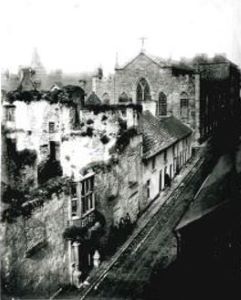THE BROWNE DOORWAY

by Tom Kenny
According to a Browne family tradition, the first Browne to settle in Ireland was Phillipus de Browne who, in 1172, was appointed Governor of Wexford. He had three sons, one of whom, Walter, settled in County Galway, where his posterity still remains. By around the year 1300, the Brownes seemed to have settled in the Athenry area. They were one of the fourteen families from the Irish lower classes who rose to become one of Galway’s prime merchant families who famously were known as The Tribes of Galway.
Like many of these families, the Brownes built a town house during the period of Galway’s civic opulence in 1607 and we still have a reminder of the great architecture of that era, the Browne Doorway. The house in Lower Abbeygate Street was derelict in 1905 and was about to be demolished when the Galway Archeological and Historical Society rescued it and had it removed carefully to Eyre Square where it became the entrance into the park.
The doorway is described as a “Free standing former entrance to Browne House of 1627, removed from its original location in 1905 to form a feature in Eyre Square. Structure comprises a rendered wall incorporating limestone doorway and oriel window. Doorway had round arch opening in slightly recessed square-headed inset, with moulded imposts flanked by engaged Tuscan columns with ionic capitals on tall pedestals, latter with moulded diamond-shaped panels, having moulded blocks above capitals and supporting pulvinated frieze and moulded cornice, below frieze is architrave and below that is a quotation from Psalms 127:1, “Nisi Dominus aedicaverit domum, in vanum laboraverunt, qui aedificat eam”, “If the Lord does not build a home, then those who build it work in vain”. Central five-light window has chamfered mullions and transom, apron between window and doorway having coat of arms of Martin Browne and Marie Lynch, with engraved date and low relief dragons to sides”.

The doorway displays fine carved detailing … just think of how long it took a stonemason to carve it all. The coats of arms of two families was a typical device found in medieval and late medieval contexts. The Browne coat of arms are on the left side and described as “Argent and eagle displayed sable”; the Lynch arms are on the right and described as “Azure on a chevron between thee trefoils slipped or”.
Our photographs show the doorway c.1865 courtesy of Chetham Library in Manchester, and also in its original location on Lower Abbeygate Street c. 1865, courtesy of the Blake Forster collection in the National Library.
The tourist literature tells us that ‘the relocation of the structure to Eyre Square has salvaged something of the building while enhancing Galway’s finest civic space’. That may have been true while there were railings around the Square, but today, standing in isolation and encased in concrete, it is more like a monument to casual preservation and seems very out of place in ‘Galway’s finest civic space’.
Our thanks to Adrian Martyn for his help with this article. If you want to know more about the Browne family, you will find them in his book "The Tribes of Galway".
.png)